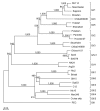Antigenic diversity of human sapoviruses
- PMID: 18258001
- PMCID: PMC2851512
- DOI: 10.3201/eid1310.070402
Antigenic diversity of human sapoviruses
Abstract
Sapovirus (SaV) is a causative agent of gastroenteritis. On the basis of capsid protein (VP1) nucleotide sequences, SaV can be divided into 5 genogroups (GI-GV), of which the GI, GII, GIV, and GV strains infect humans. SaV is uncultivable, but expression of recombinant VP1 in insect cells results in formation of viruslike particles (VLPs) that are antigenically similar to native SaV. In this study, we newly expressed SaV GII and GIV VLPs to compare genetic and antigenic relationships among all human SaV genogroups. Hyperimmune antiserum samples against VLPs reacted strongly with homologous VLPs. However, several antiserum samples weakly cross-reacted against heterologous VLPs in an antibody ELISA. Conversely, an antigen ELISA showed that VLPs of SaV in all human genogroups were antigenically distinct. These findings indicate a likely correspondence between SaV antigenicity and VP1 genogrouping and genotyping.
Figures




Similar articles
-
Cross-reactivity among sapovirus recombinant capsid proteins.Arch Virol. 2005 Jan;150(1):21-36. doi: 10.1007/s00705-004-0406-8. Epub 2004 Sep 24. Arch Virol. 2005. PMID: 15449145
-
Novel monoclonal antibodies broadly reactive to human recombinant sapovirus-like particles.Microbiol Immunol. 2012 Nov;56(11):760-70. doi: 10.1111/j.1348-0421.2012.00499.x. Microbiol Immunol. 2012. PMID: 22924483
-
Prevalence and genetic diversity of human sapovirus associated with sporadic acute gastroenteritis in South China from 2013 to 2017.J Med Virol. 2019 Oct;91(10):1759-1764. doi: 10.1002/jmv.25511. Epub 2019 Jun 25. J Med Virol. 2019. PMID: 31180139
-
Human sapoviruses: genetic diversity, recombination, and classification.Rev Med Virol. 2007 Mar-Apr;17(2):133-41. doi: 10.1002/rmv.533. Rev Med Virol. 2007. PMID: 17340567 Review.
-
Molecular epidemiology and genotype distributions of noroviruses and sapoviruses in Thailand 2000-2016: A review.J Med Virol. 2018 Apr;90(4):617-624. doi: 10.1002/jmv.25019. Epub 2018 Jan 23. J Med Virol. 2018. PMID: 29315631 Review.
Cited by
-
Propagating and banking genetically diverse human sapovirus strains using a human duodenal cell line: investigating antigenic differences between strains.J Virol. 2024 Sep 17;98(9):e0063924. doi: 10.1128/jvi.00639-24. Epub 2024 Aug 12. J Virol. 2024. PMID: 39132992
-
Metagenomic Detection and Genetic Characterization of Human Sapoviruses among Children with Acute Flaccid Paralysis in Nigeria.Pathogens. 2024 Mar 19;13(3):264. doi: 10.3390/pathogens13030264. Pathogens. 2024. PMID: 38535607 Free PMC article.
-
High-resolution melting analysis for simultaneous detection and discrimination between wild-type and vaccine strains of feline calicivirus.Vet Q. 2023 Dec;43(1):1-12. doi: 10.1080/01652176.2023.2272188. Epub 2023 Nov 1. Vet Q. 2023. PMID: 37851857 Free PMC article.
-
Timing and genotype distribution of symptomatic and asymptomatic sapovirus infections and re-infections in a Nicaraguan birth cohort.Clin Microbiol Infect. 2023 Apr;29(4):540.e9-540.e15. doi: 10.1016/j.cmi.2022.11.013. Epub 2022 Nov 21. Clin Microbiol Infect. 2023. PMID: 36423864 Free PMC article.
-
Characterization of a Human Sapovirus Genotype GII.3 Strain Generated by a Reverse Genetics System: VP2 Is a Minor Structural Protein of the Virion.Viruses. 2022 Jul 27;14(8):1649. doi: 10.3390/v14081649. Viruses. 2022. PMID: 36016271 Free PMC article.
References
Publication types
MeSH terms
Substances
LinkOut - more resources
Full Text Sources
Other Literature Sources
Medical
